Tesco Service Based Organisation Report 2022
VerifiedAdded on 2022/06/08
|10
|2882
|24
AI Summary
Contribute Materials
Your contribution can guide someone’s learning journey. Share your
documents today.
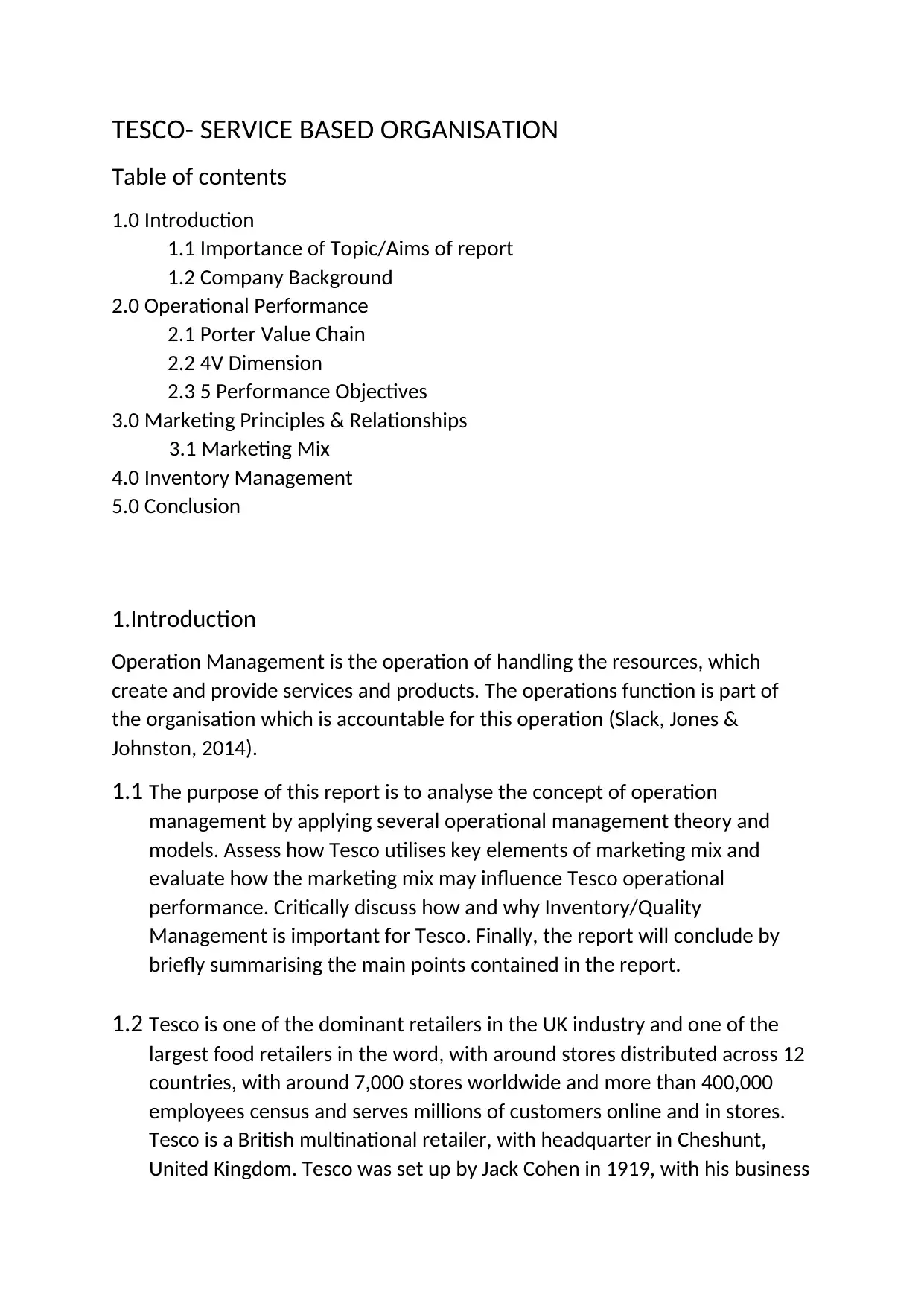
TESCO- SERVICE BASED ORGANISATION
Table of contents
1.0 Introduction
1.1 Importance of Topic/Aims of report
1.2 Company Background
2.0 Operational Performance
2.1 Porter Value Chain
2.2 4V Dimension
2.3 5 Performance Objectives
3.0 Marketing Principles & Relationships
3.1 Marketing Mix
4.0 Inventory Management
5.0 Conclusion
1.Introduction
Operation Management is the operation of handling the resources, which
create and provide services and products. The operations function is part of
the organisation which is accountable for this operation (Slack, Jones &
Johnston, 2014).
1.1 The purpose of this report is to analyse the concept of operation
management by applying several operational management theory and
models. Assess how Tesco utilises key elements of marketing mix and
evaluate how the marketing mix may influence Tesco operational
performance. Critically discuss how and why Inventory/Quality
Management is important for Tesco. Finally, the report will conclude by
briefly summarising the main points contained in the report.
1.2 Tesco is one of the dominant retailers in the UK industry and one of the
largest food retailers in the word, with around stores distributed across 12
countries, with around 7,000 stores worldwide and more than 400,000
employees census and serves millions of customers online and in stores.
Tesco is a British multinational retailer, with headquarter in Cheshunt,
United Kingdom. Tesco was set up by Jack Cohen in 1919, with his business
Table of contents
1.0 Introduction
1.1 Importance of Topic/Aims of report
1.2 Company Background
2.0 Operational Performance
2.1 Porter Value Chain
2.2 4V Dimension
2.3 5 Performance Objectives
3.0 Marketing Principles & Relationships
3.1 Marketing Mix
4.0 Inventory Management
5.0 Conclusion
1.Introduction
Operation Management is the operation of handling the resources, which
create and provide services and products. The operations function is part of
the organisation which is accountable for this operation (Slack, Jones &
Johnston, 2014).
1.1 The purpose of this report is to analyse the concept of operation
management by applying several operational management theory and
models. Assess how Tesco utilises key elements of marketing mix and
evaluate how the marketing mix may influence Tesco operational
performance. Critically discuss how and why Inventory/Quality
Management is important for Tesco. Finally, the report will conclude by
briefly summarising the main points contained in the report.
1.2 Tesco is one of the dominant retailers in the UK industry and one of the
largest food retailers in the word, with around stores distributed across 12
countries, with around 7,000 stores worldwide and more than 400,000
employees census and serves millions of customers online and in stores.
Tesco is a British multinational retailer, with headquarter in Cheshunt,
United Kingdom. Tesco was set up by Jack Cohen in 1919, with his business
Secure Best Marks with AI Grader
Need help grading? Try our AI Grader for instant feedback on your assignments.
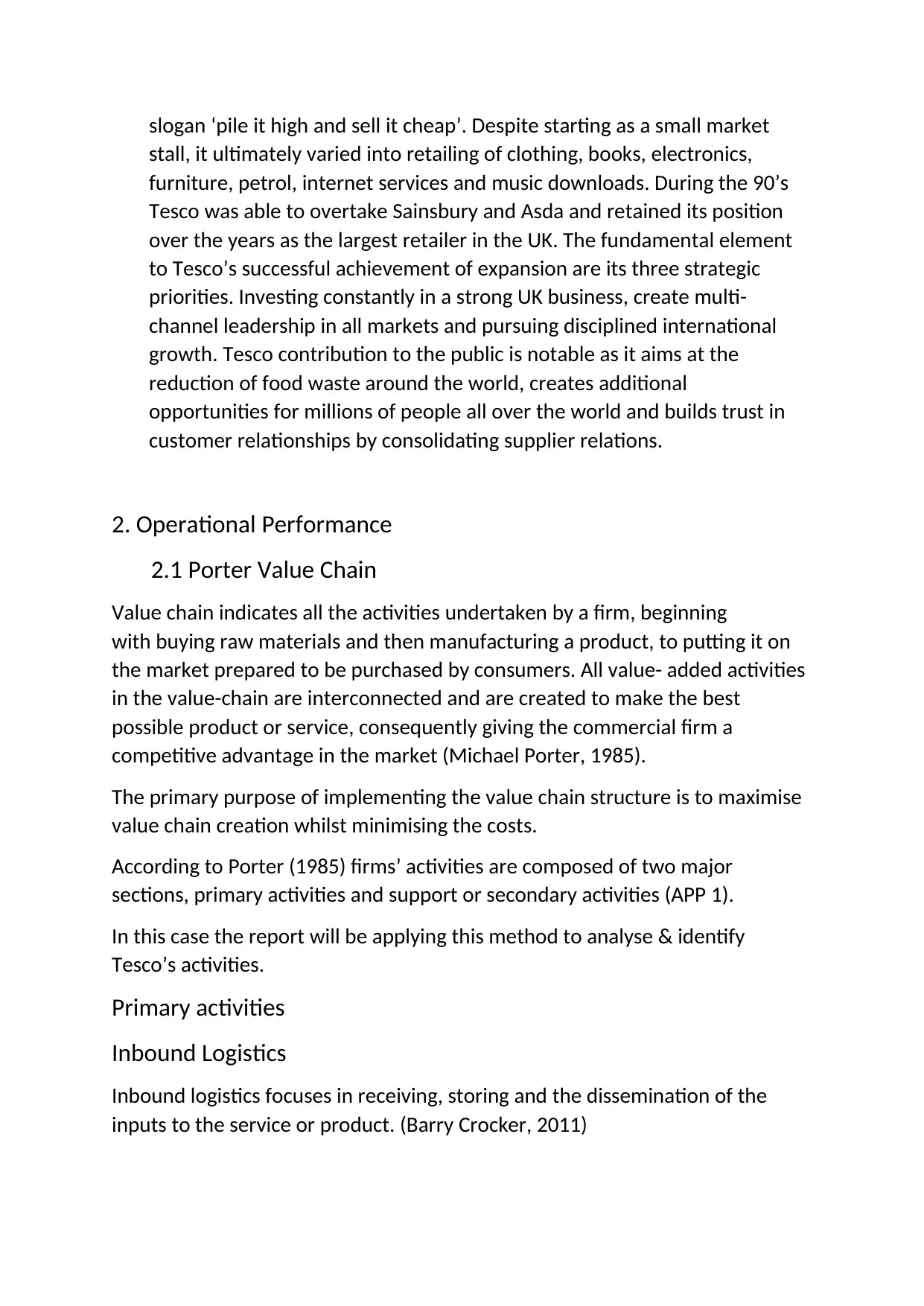
slogan ‘pile it high and sell it cheap’. Despite starting as a small market
stall, it ultimately varied into retailing of clothing, books, electronics,
furniture, petrol, internet services and music downloads. During the 90’s
Tesco was able to overtake Sainsbury and Asda and retained its position
over the years as the largest retailer in the UK. The fundamental element
to Tesco’s successful achievement of expansion are its three strategic
priorities. Investing constantly in a strong UK business, create multi-
channel leadership in all markets and pursuing disciplined international
growth. Tesco contribution to the public is notable as it aims at the
reduction of food waste around the world, creates additional
opportunities for millions of people all over the world and builds trust in
customer relationships by consolidating supplier relations.
2. Operational Performance
2.1 Porter Value Chain
Value chain indicates all the activities undertaken by a firm, beginning
with buying raw materials and then manufacturing a product, to putting it on
the market prepared to be purchased by consumers. All value- added activities
in the value-chain are interconnected and are created to make the best
possible product or service, consequently giving the commercial firm a
competitive advantage in the market (Michael Porter, 1985).
The primary purpose of implementing the value chain structure is to maximise
value chain creation whilst minimising the costs.
According to Porter (1985) firms’ activities are composed of two major
sections, primary activities and support or secondary activities (APP 1).
In this case the report will be applying this method to analyse & identify
Tesco’s activities.
Primary activities
Inbound Logistics
Inbound logistics focuses in receiving, storing and the dissemination of the
inputs to the service or product. (Barry Crocker, 2011)
stall, it ultimately varied into retailing of clothing, books, electronics,
furniture, petrol, internet services and music downloads. During the 90’s
Tesco was able to overtake Sainsbury and Asda and retained its position
over the years as the largest retailer in the UK. The fundamental element
to Tesco’s successful achievement of expansion are its three strategic
priorities. Investing constantly in a strong UK business, create multi-
channel leadership in all markets and pursuing disciplined international
growth. Tesco contribution to the public is notable as it aims at the
reduction of food waste around the world, creates additional
opportunities for millions of people all over the world and builds trust in
customer relationships by consolidating supplier relations.
2. Operational Performance
2.1 Porter Value Chain
Value chain indicates all the activities undertaken by a firm, beginning
with buying raw materials and then manufacturing a product, to putting it on
the market prepared to be purchased by consumers. All value- added activities
in the value-chain are interconnected and are created to make the best
possible product or service, consequently giving the commercial firm a
competitive advantage in the market (Michael Porter, 1985).
The primary purpose of implementing the value chain structure is to maximise
value chain creation whilst minimising the costs.
According to Porter (1985) firms’ activities are composed of two major
sections, primary activities and support or secondary activities (APP 1).
In this case the report will be applying this method to analyse & identify
Tesco’s activities.
Primary activities
Inbound Logistics
Inbound logistics focuses in receiving, storing and the dissemination of the
inputs to the service or product. (Barry Crocker, 2011)
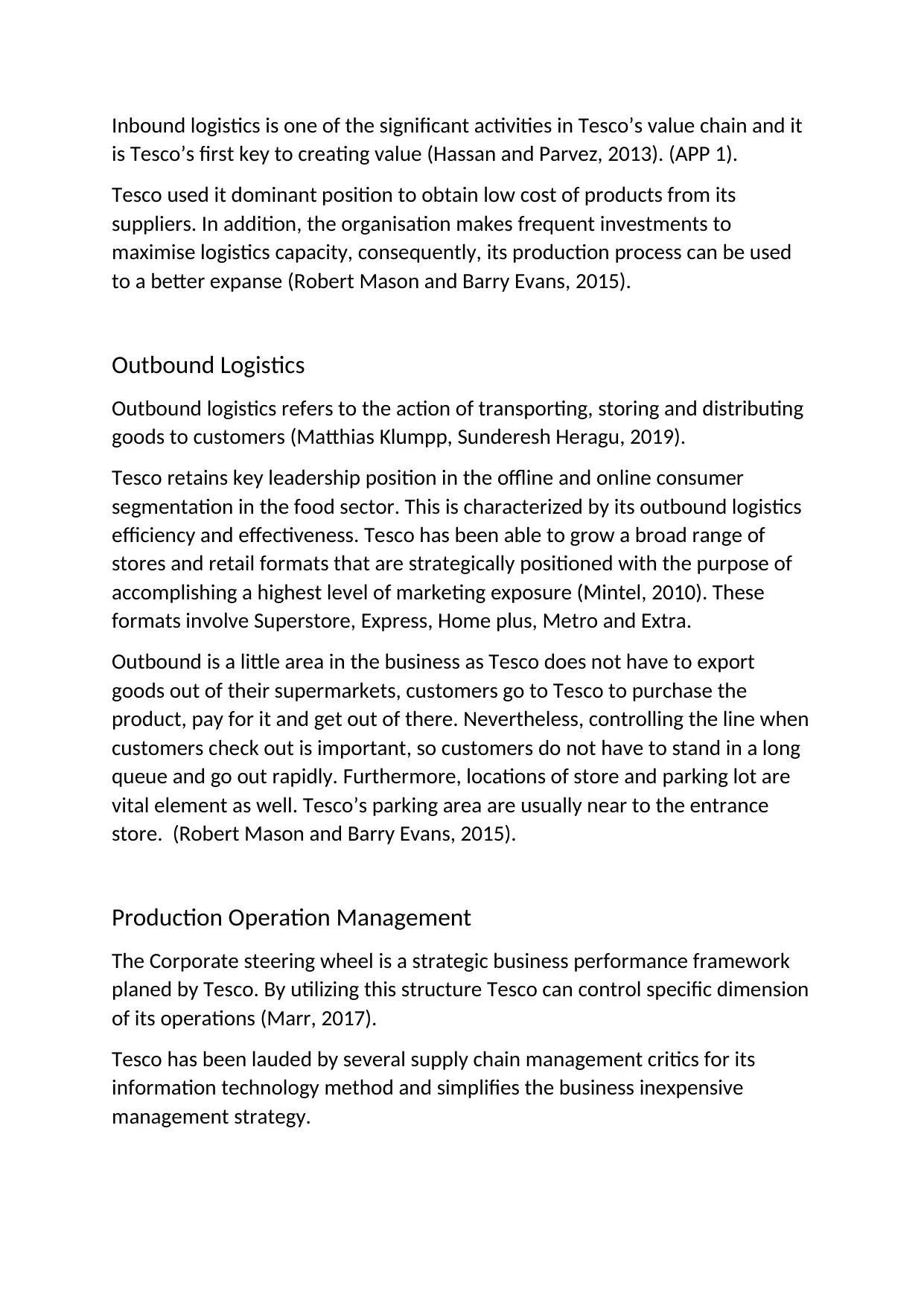
Inbound logistics is one of the significant activities in Tesco’s value chain and it
is Tesco’s first key to creating value (Hassan and Parvez, 2013). (APP 1).
Tesco used it dominant position to obtain low cost of products from its
suppliers. In addition, the organisation makes frequent investments to
maximise logistics capacity, consequently, its production process can be used
to a better expanse (Robert Mason and Barry Evans, 2015).
Outbound Logistics
Outbound logistics refers to the action of transporting, storing and distributing
goods to customers (Matthias Klumpp, Sunderesh Heragu, 2019).
Tesco retains key leadership position in the offline and online consumer
segmentation in the food sector. This is characterized by its outbound logistics
efficiency and effectiveness. Tesco has been able to grow a broad range of
stores and retail formats that are strategically positioned with the purpose of
accomplishing a highest level of marketing exposure (Mintel, 2010). These
formats involve Superstore, Express, Home plus, Metro and Extra.
Outbound is a little area in the business as Tesco does not have to export
goods out of their supermarkets, customers go to Tesco to purchase the
product, pay for it and get out of there. Nevertheless, controlling the line when
customers check out is important, so customers do not have to stand in a long
queue and go out rapidly. Furthermore, locations of store and parking lot are
vital element as well. Tesco’s parking area are usually near to the entrance
store. (Robert Mason and Barry Evans, 2015).
Production Operation Management
The Corporate steering wheel is a strategic business performance framework
planed by Tesco. By utilizing this structure Tesco can control specific dimension
of its operations (Marr, 2017).
Tesco has been lauded by several supply chain management critics for its
information technology method and simplifies the business inexpensive
management strategy.
is Tesco’s first key to creating value (Hassan and Parvez, 2013). (APP 1).
Tesco used it dominant position to obtain low cost of products from its
suppliers. In addition, the organisation makes frequent investments to
maximise logistics capacity, consequently, its production process can be used
to a better expanse (Robert Mason and Barry Evans, 2015).
Outbound Logistics
Outbound logistics refers to the action of transporting, storing and distributing
goods to customers (Matthias Klumpp, Sunderesh Heragu, 2019).
Tesco retains key leadership position in the offline and online consumer
segmentation in the food sector. This is characterized by its outbound logistics
efficiency and effectiveness. Tesco has been able to grow a broad range of
stores and retail formats that are strategically positioned with the purpose of
accomplishing a highest level of marketing exposure (Mintel, 2010). These
formats involve Superstore, Express, Home plus, Metro and Extra.
Outbound is a little area in the business as Tesco does not have to export
goods out of their supermarkets, customers go to Tesco to purchase the
product, pay for it and get out of there. Nevertheless, controlling the line when
customers check out is important, so customers do not have to stand in a long
queue and go out rapidly. Furthermore, locations of store and parking lot are
vital element as well. Tesco’s parking area are usually near to the entrance
store. (Robert Mason and Barry Evans, 2015).
Production Operation Management
The Corporate steering wheel is a strategic business performance framework
planed by Tesco. By utilizing this structure Tesco can control specific dimension
of its operations (Marr, 2017).
Tesco has been lauded by several supply chain management critics for its
information technology method and simplifies the business inexpensive
management strategy.

For instance, the firm has invested £1 billion to increase its UK operations, to
improve shopping experience and its UK stores, that will involve recruitment of
extra workers and delivering better value for money to customers
(www.bbc.co.uk, 2012).
Marketing & Sales
Marketing and Sales are activities that make a product available for buyers and
induces them to buy.
“Every Little Helps” motto is the principal marketing communication message
of the store chain (Tesco, 1993).
The firm utilises online and offline sales channel and in these channels its
marketing and sales activities are promotional activities, advertising, pricing
and creating relationships with channel members
(www.marketingweek.com,2020).
Tesco has initiated Loyalty Tesco Club Card and its Greener Living Scheme to
keep customers from going to their competitors by providing discounts and
give customer advice on environmental problems, as well as how customers
can decrease food wastage and carbon footprint when cooking their meals.
This will automatically add value for customers who will think that by going for
Tesco, they are helping the environs (www.theguardian.com, 2011).
Procurement
Procurement comprises buying activities that need require containment to
develop firm efficiency. It permits companies to buy products or services
necessary as working capital. A useful procurement strategy examines supplier
input in ordering, internal processing, evaluating, to maximise process stages
and for effective process control (Fernie & Sparks, 2009).
Tesco sells its goods using online and offline stores. Tesco is a company that
purchases goods in large quantity with a broad network of suppliers. The
products are received from suppliers that fulfil the retailer’s capacity and
quality standards in a brief period to fulfil customer demand. It is calculated
that around 2.1 billion goods are supplied to Tesco store every year (Tesco PLC,
2015).
improve shopping experience and its UK stores, that will involve recruitment of
extra workers and delivering better value for money to customers
(www.bbc.co.uk, 2012).
Marketing & Sales
Marketing and Sales are activities that make a product available for buyers and
induces them to buy.
“Every Little Helps” motto is the principal marketing communication message
of the store chain (Tesco, 1993).
The firm utilises online and offline sales channel and in these channels its
marketing and sales activities are promotional activities, advertising, pricing
and creating relationships with channel members
(www.marketingweek.com,2020).
Tesco has initiated Loyalty Tesco Club Card and its Greener Living Scheme to
keep customers from going to their competitors by providing discounts and
give customer advice on environmental problems, as well as how customers
can decrease food wastage and carbon footprint when cooking their meals.
This will automatically add value for customers who will think that by going for
Tesco, they are helping the environs (www.theguardian.com, 2011).
Procurement
Procurement comprises buying activities that need require containment to
develop firm efficiency. It permits companies to buy products or services
necessary as working capital. A useful procurement strategy examines supplier
input in ordering, internal processing, evaluating, to maximise process stages
and for effective process control (Fernie & Sparks, 2009).
Tesco sells its goods using online and offline stores. Tesco is a company that
purchases goods in large quantity with a broad network of suppliers. The
products are received from suppliers that fulfil the retailer’s capacity and
quality standards in a brief period to fulfil customer demand. It is calculated
that around 2.1 billion goods are supplied to Tesco store every year (Tesco PLC,
2015).
Secure Best Marks with AI Grader
Need help grading? Try our AI Grader for instant feedback on your assignments.
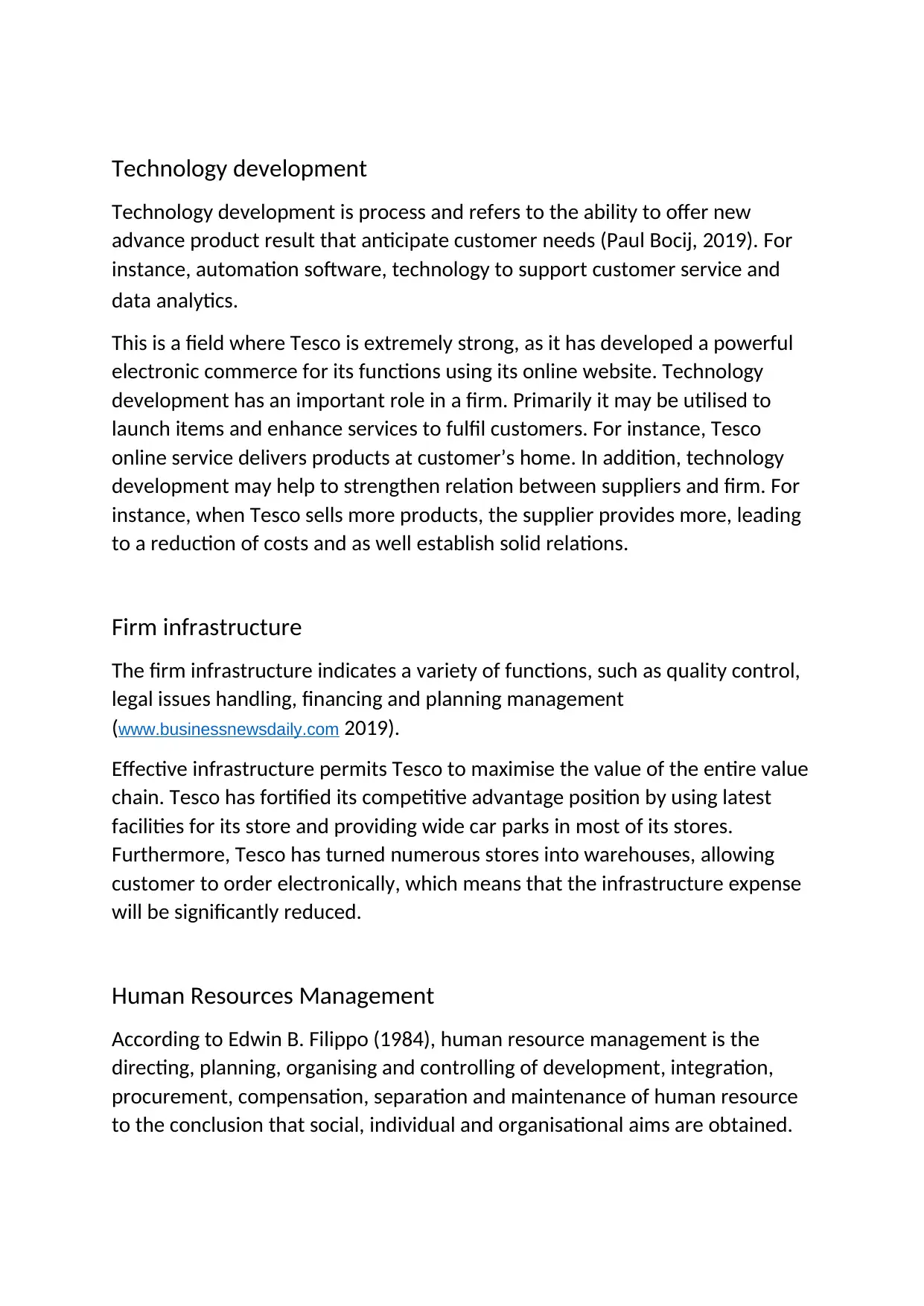
Technology development
Technology development is process and refers to the ability to offer new
advance product result that anticipate customer needs (Paul Bocij, 2019). For
instance, automation software, technology to support customer service and
data analytics.
This is a field where Tesco is extremely strong, as it has developed a powerful
electronic commerce for its functions using its online website. Technology
development has an important role in a firm. Primarily it may be utilised to
launch items and enhance services to fulfil customers. For instance, Tesco
online service delivers products at customer’s home. In addition, technology
development may help to strengthen relation between suppliers and firm. For
instance, when Tesco sells more products, the supplier provides more, leading
to a reduction of costs and as well establish solid relations.
Firm infrastructure
The firm infrastructure indicates a variety of functions, such as quality control,
legal issues handling, financing and planning management
(www.businessnewsdaily.com 2019).
Effective infrastructure permits Tesco to maximise the value of the entire value
chain. Tesco has fortified its competitive advantage position by using latest
facilities for its store and providing wide car parks in most of its stores.
Furthermore, Tesco has turned numerous stores into warehouses, allowing
customer to order electronically, which means that the infrastructure expense
will be significantly reduced.
Human Resources Management
According to Edwin B. Filippo (1984), human resource management is the
directing, planning, organising and controlling of development, integration,
procurement, compensation, separation and maintenance of human resource
to the conclusion that social, individual and organisational aims are obtained.
Technology development is process and refers to the ability to offer new
advance product result that anticipate customer needs (Paul Bocij, 2019). For
instance, automation software, technology to support customer service and
data analytics.
This is a field where Tesco is extremely strong, as it has developed a powerful
electronic commerce for its functions using its online website. Technology
development has an important role in a firm. Primarily it may be utilised to
launch items and enhance services to fulfil customers. For instance, Tesco
online service delivers products at customer’s home. In addition, technology
development may help to strengthen relation between suppliers and firm. For
instance, when Tesco sells more products, the supplier provides more, leading
to a reduction of costs and as well establish solid relations.
Firm infrastructure
The firm infrastructure indicates a variety of functions, such as quality control,
legal issues handling, financing and planning management
(www.businessnewsdaily.com 2019).
Effective infrastructure permits Tesco to maximise the value of the entire value
chain. Tesco has fortified its competitive advantage position by using latest
facilities for its store and providing wide car parks in most of its stores.
Furthermore, Tesco has turned numerous stores into warehouses, allowing
customer to order electronically, which means that the infrastructure expense
will be significantly reduced.
Human Resources Management
According to Edwin B. Filippo (1984), human resource management is the
directing, planning, organising and controlling of development, integration,
procurement, compensation, separation and maintenance of human resource
to the conclusion that social, individual and organisational aims are obtained.
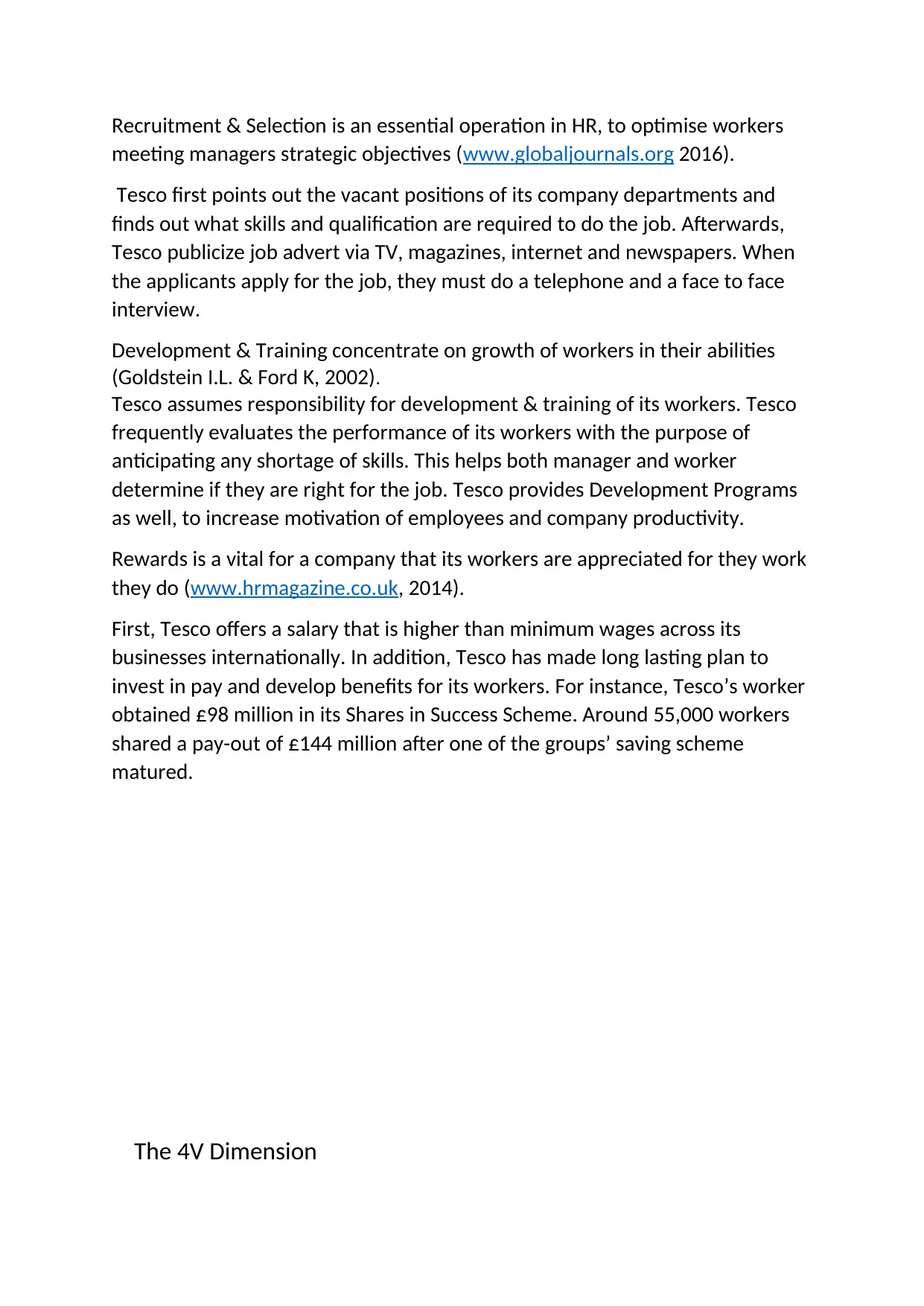
Recruitment & Selection is an essential operation in HR, to optimise workers
meeting managers strategic objectives (www.globaljournals.org 2016).
Tesco first points out the vacant positions of its company departments and
finds out what skills and qualification are required to do the job. Afterwards,
Tesco publicize job advert via TV, magazines, internet and newspapers. When
the applicants apply for the job, they must do a telephone and a face to face
interview.
Development & Training concentrate on growth of workers in their abilities
(Goldstein I.L. & Ford K, 2002).
Tesco assumes responsibility for development & training of its workers. Tesco
frequently evaluates the performance of its workers with the purpose of
anticipating any shortage of skills. This helps both manager and worker
determine if they are right for the job. Tesco provides Development Programs
as well, to increase motivation of employees and company productivity.
Rewards is a vital for a company that its workers are appreciated for they work
they do (www.hrmagazine.co.uk, 2014).
First, Tesco offers a salary that is higher than minimum wages across its
businesses internationally. In addition, Tesco has made long lasting plan to
invest in pay and develop benefits for its workers. For instance, Tesco’s worker
obtained £98 million in its Shares in Success Scheme. Around 55,000 workers
shared a pay-out of £144 million after one of the groups’ saving scheme
matured.
The 4V Dimension
meeting managers strategic objectives (www.globaljournals.org 2016).
Tesco first points out the vacant positions of its company departments and
finds out what skills and qualification are required to do the job. Afterwards,
Tesco publicize job advert via TV, magazines, internet and newspapers. When
the applicants apply for the job, they must do a telephone and a face to face
interview.
Development & Training concentrate on growth of workers in their abilities
(Goldstein I.L. & Ford K, 2002).
Tesco assumes responsibility for development & training of its workers. Tesco
frequently evaluates the performance of its workers with the purpose of
anticipating any shortage of skills. This helps both manager and worker
determine if they are right for the job. Tesco provides Development Programs
as well, to increase motivation of employees and company productivity.
Rewards is a vital for a company that its workers are appreciated for they work
they do (www.hrmagazine.co.uk, 2014).
First, Tesco offers a salary that is higher than minimum wages across its
businesses internationally. In addition, Tesco has made long lasting plan to
invest in pay and develop benefits for its workers. For instance, Tesco’s worker
obtained £98 million in its Shares in Success Scheme. Around 55,000 workers
shared a pay-out of £144 million after one of the groups’ saving scheme
matured.
The 4V Dimension
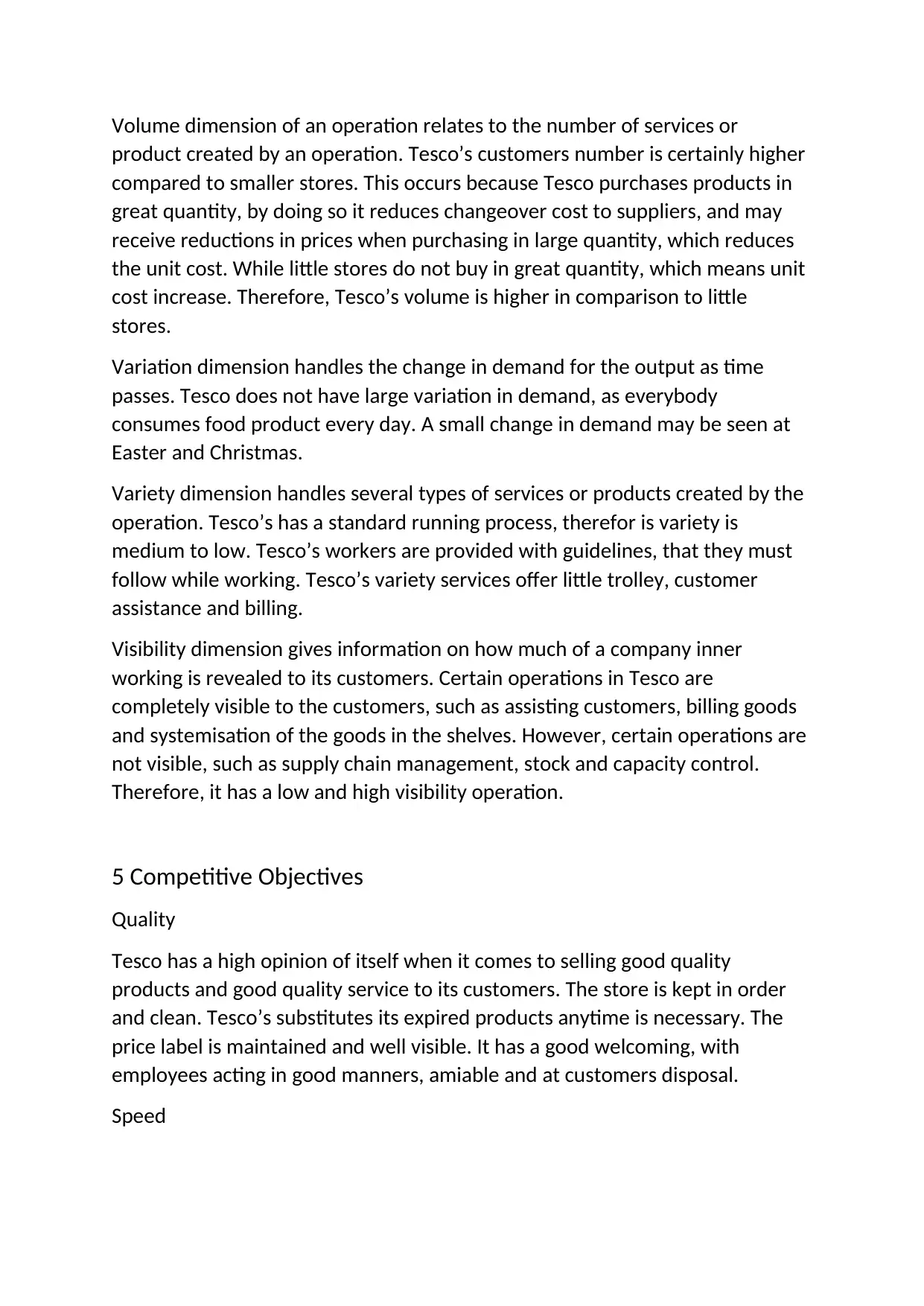
Volume dimension of an operation relates to the number of services or
product created by an operation. Tesco’s customers number is certainly higher
compared to smaller stores. This occurs because Tesco purchases products in
great quantity, by doing so it reduces changeover cost to suppliers, and may
receive reductions in prices when purchasing in large quantity, which reduces
the unit cost. While little stores do not buy in great quantity, which means unit
cost increase. Therefore, Tesco’s volume is higher in comparison to little
stores.
Variation dimension handles the change in demand for the output as time
passes. Tesco does not have large variation in demand, as everybody
consumes food product every day. A small change in demand may be seen at
Easter and Christmas.
Variety dimension handles several types of services or products created by the
operation. Tesco’s has a standard running process, therefor is variety is
medium to low. Tesco’s workers are provided with guidelines, that they must
follow while working. Tesco’s variety services offer little trolley, customer
assistance and billing.
Visibility dimension gives information on how much of a company inner
working is revealed to its customers. Certain operations in Tesco are
completely visible to the customers, such as assisting customers, billing goods
and systemisation of the goods in the shelves. However, certain operations are
not visible, such as supply chain management, stock and capacity control.
Therefore, it has a low and high visibility operation.
5 Competitive Objectives
Quality
Tesco has a high opinion of itself when it comes to selling good quality
products and good quality service to its customers. The store is kept in order
and clean. Tesco’s substitutes its expired products anytime is necessary. The
price label is maintained and well visible. It has a good welcoming, with
employees acting in good manners, amiable and at customers disposal.
Speed
product created by an operation. Tesco’s customers number is certainly higher
compared to smaller stores. This occurs because Tesco purchases products in
great quantity, by doing so it reduces changeover cost to suppliers, and may
receive reductions in prices when purchasing in large quantity, which reduces
the unit cost. While little stores do not buy in great quantity, which means unit
cost increase. Therefore, Tesco’s volume is higher in comparison to little
stores.
Variation dimension handles the change in demand for the output as time
passes. Tesco does not have large variation in demand, as everybody
consumes food product every day. A small change in demand may be seen at
Easter and Christmas.
Variety dimension handles several types of services or products created by the
operation. Tesco’s has a standard running process, therefor is variety is
medium to low. Tesco’s workers are provided with guidelines, that they must
follow while working. Tesco’s variety services offer little trolley, customer
assistance and billing.
Visibility dimension gives information on how much of a company inner
working is revealed to its customers. Certain operations in Tesco are
completely visible to the customers, such as assisting customers, billing goods
and systemisation of the goods in the shelves. However, certain operations are
not visible, such as supply chain management, stock and capacity control.
Therefore, it has a low and high visibility operation.
5 Competitive Objectives
Quality
Tesco has a high opinion of itself when it comes to selling good quality
products and good quality service to its customers. The store is kept in order
and clean. Tesco’s substitutes its expired products anytime is necessary. The
price label is maintained and well visible. It has a good welcoming, with
employees acting in good manners, amiable and at customers disposal.
Speed
Paraphrase This Document
Need a fresh take? Get an instant paraphrase of this document with our AI Paraphraser
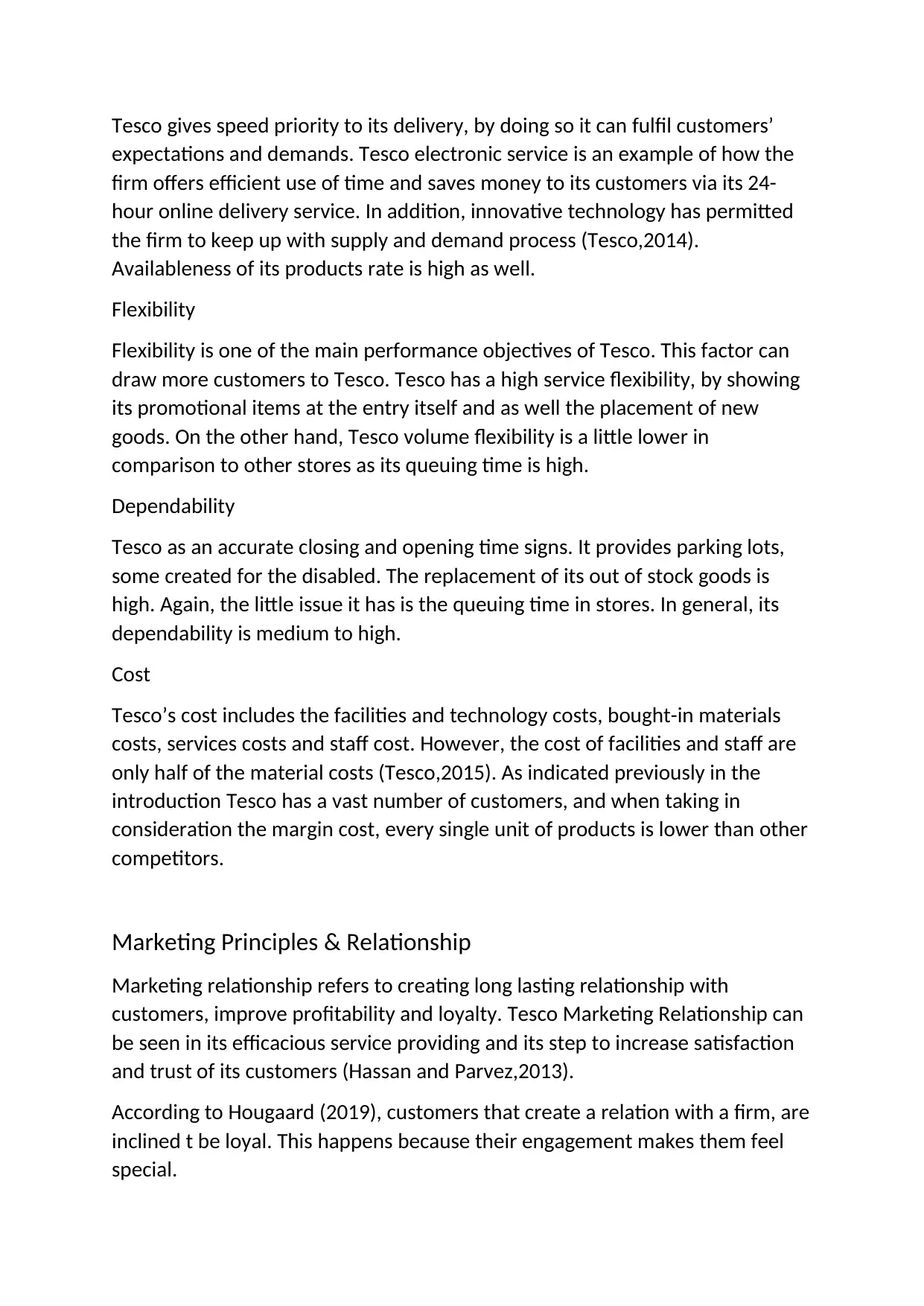
Tesco gives speed priority to its delivery, by doing so it can fulfil customers’
expectations and demands. Tesco electronic service is an example of how the
firm offers efficient use of time and saves money to its customers via its 24-
hour online delivery service. In addition, innovative technology has permitted
the firm to keep up with supply and demand process (Tesco,2014).
Availableness of its products rate is high as well.
Flexibility
Flexibility is one of the main performance objectives of Tesco. This factor can
draw more customers to Tesco. Tesco has a high service flexibility, by showing
its promotional items at the entry itself and as well the placement of new
goods. On the other hand, Tesco volume flexibility is a little lower in
comparison to other stores as its queuing time is high.
Dependability
Tesco as an accurate closing and opening time signs. It provides parking lots,
some created for the disabled. The replacement of its out of stock goods is
high. Again, the little issue it has is the queuing time in stores. In general, its
dependability is medium to high.
Cost
Tesco’s cost includes the facilities and technology costs, bought-in materials
costs, services costs and staff cost. However, the cost of facilities and staff are
only half of the material costs (Tesco,2015). As indicated previously in the
introduction Tesco has a vast number of customers, and when taking in
consideration the margin cost, every single unit of products is lower than other
competitors.
Marketing Principles & Relationship
Marketing relationship refers to creating long lasting relationship with
customers, improve profitability and loyalty. Tesco Marketing Relationship can
be seen in its efficacious service providing and its step to increase satisfaction
and trust of its customers (Hassan and Parvez,2013).
According to Hougaard (2019), customers that create a relation with a firm, are
inclined t be loyal. This happens because their engagement makes them feel
special.
expectations and demands. Tesco electronic service is an example of how the
firm offers efficient use of time and saves money to its customers via its 24-
hour online delivery service. In addition, innovative technology has permitted
the firm to keep up with supply and demand process (Tesco,2014).
Availableness of its products rate is high as well.
Flexibility
Flexibility is one of the main performance objectives of Tesco. This factor can
draw more customers to Tesco. Tesco has a high service flexibility, by showing
its promotional items at the entry itself and as well the placement of new
goods. On the other hand, Tesco volume flexibility is a little lower in
comparison to other stores as its queuing time is high.
Dependability
Tesco as an accurate closing and opening time signs. It provides parking lots,
some created for the disabled. The replacement of its out of stock goods is
high. Again, the little issue it has is the queuing time in stores. In general, its
dependability is medium to high.
Cost
Tesco’s cost includes the facilities and technology costs, bought-in materials
costs, services costs and staff cost. However, the cost of facilities and staff are
only half of the material costs (Tesco,2015). As indicated previously in the
introduction Tesco has a vast number of customers, and when taking in
consideration the margin cost, every single unit of products is lower than other
competitors.
Marketing Principles & Relationship
Marketing relationship refers to creating long lasting relationship with
customers, improve profitability and loyalty. Tesco Marketing Relationship can
be seen in its efficacious service providing and its step to increase satisfaction
and trust of its customers (Hassan and Parvez,2013).
According to Hougaard (2019), customers that create a relation with a firm, are
inclined t be loyal. This happens because their engagement makes them feel
special.
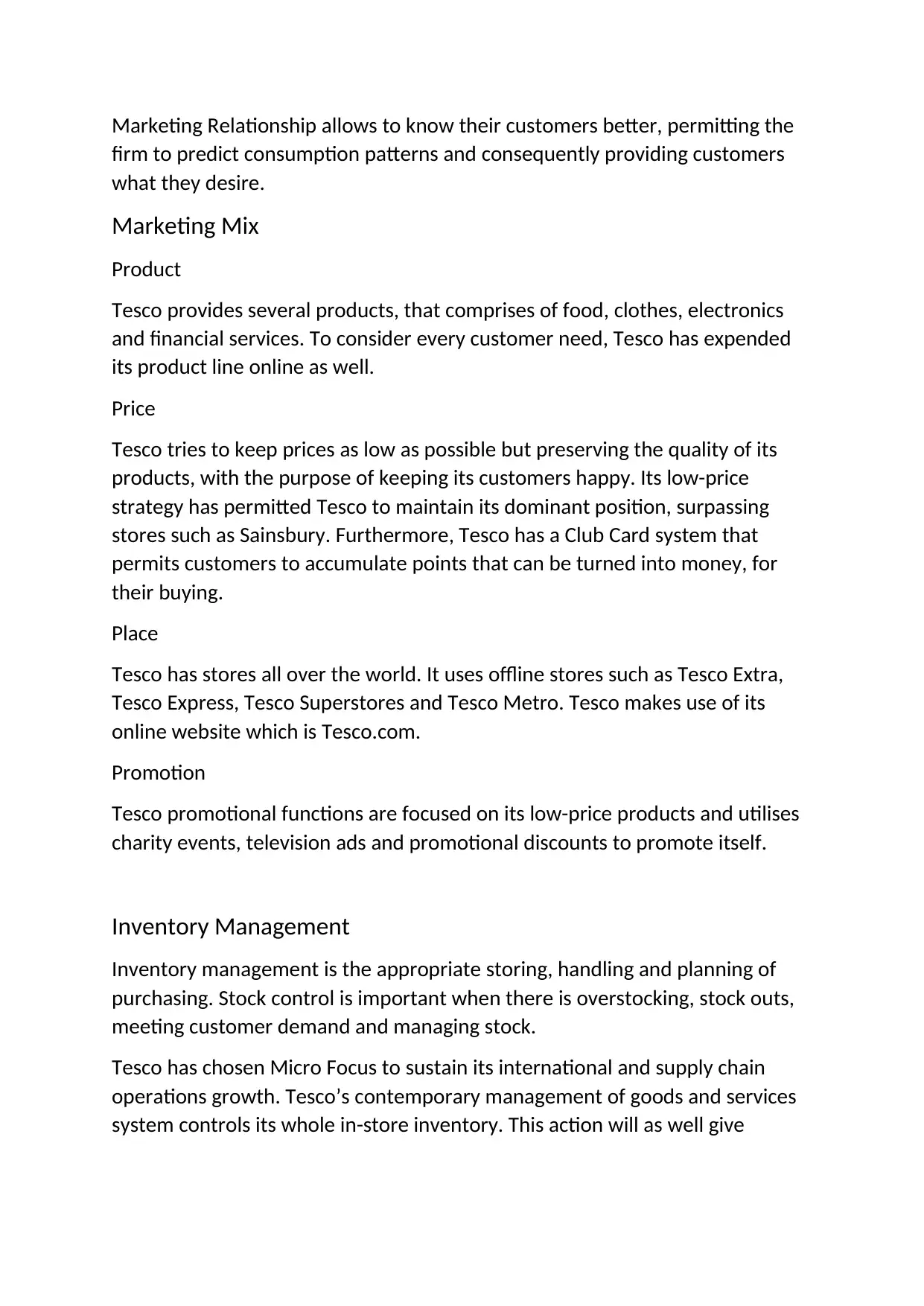
Marketing Relationship allows to know their customers better, permitting the
firm to predict consumption patterns and consequently providing customers
what they desire.
Marketing Mix
Product
Tesco provides several products, that comprises of food, clothes, electronics
and financial services. To consider every customer need, Tesco has expended
its product line online as well.
Price
Tesco tries to keep prices as low as possible but preserving the quality of its
products, with the purpose of keeping its customers happy. Its low-price
strategy has permitted Tesco to maintain its dominant position, surpassing
stores such as Sainsbury. Furthermore, Tesco has a Club Card system that
permits customers to accumulate points that can be turned into money, for
their buying.
Place
Tesco has stores all over the world. It uses offline stores such as Tesco Extra,
Tesco Express, Tesco Superstores and Tesco Metro. Tesco makes use of its
online website which is Tesco.com.
Promotion
Tesco promotional functions are focused on its low-price products and utilises
charity events, television ads and promotional discounts to promote itself.
Inventory Management
Inventory management is the appropriate storing, handling and planning of
purchasing. Stock control is important when there is overstocking, stock outs,
meeting customer demand and managing stock.
Tesco has chosen Micro Focus to sustain its international and supply chain
operations growth. Tesco’s contemporary management of goods and services
system controls its whole in-store inventory. This action will as well give
firm to predict consumption patterns and consequently providing customers
what they desire.
Marketing Mix
Product
Tesco provides several products, that comprises of food, clothes, electronics
and financial services. To consider every customer need, Tesco has expended
its product line online as well.
Price
Tesco tries to keep prices as low as possible but preserving the quality of its
products, with the purpose of keeping its customers happy. Its low-price
strategy has permitted Tesco to maintain its dominant position, surpassing
stores such as Sainsbury. Furthermore, Tesco has a Club Card system that
permits customers to accumulate points that can be turned into money, for
their buying.
Place
Tesco has stores all over the world. It uses offline stores such as Tesco Extra,
Tesco Express, Tesco Superstores and Tesco Metro. Tesco makes use of its
online website which is Tesco.com.
Promotion
Tesco promotional functions are focused on its low-price products and utilises
charity events, television ads and promotional discounts to promote itself.
Inventory Management
Inventory management is the appropriate storing, handling and planning of
purchasing. Stock control is important when there is overstocking, stock outs,
meeting customer demand and managing stock.
Tesco has chosen Micro Focus to sustain its international and supply chain
operations growth. Tesco’s contemporary management of goods and services
system controls its whole in-store inventory. This action will as well give

significant cost savings to Tesco, as it will prevent Tesco from investing in
further support for its international operations.
Tesco has developed an analytical pattern that utilises climate patterns to
appropriately stock store shelves. For instance, if it is expected mild weather in
a location, after a cold weather, Tesco will make sure that the around stores
are fully stocked with more barbecue meat. This will help Tesco to not order
excessively, reduces wastage of food and costs and be more environmentally
friendly, as large quantity of products would otherwise need to be
refrigerated.
further support for its international operations.
Tesco has developed an analytical pattern that utilises climate patterns to
appropriately stock store shelves. For instance, if it is expected mild weather in
a location, after a cold weather, Tesco will make sure that the around stores
are fully stocked with more barbecue meat. This will help Tesco to not order
excessively, reduces wastage of food and costs and be more environmentally
friendly, as large quantity of products would otherwise need to be
refrigerated.
1 out of 10
Related Documents
Your All-in-One AI-Powered Toolkit for Academic Success.
+13062052269
info@desklib.com
Available 24*7 on WhatsApp / Email
![[object Object]](/_next/static/media/star-bottom.7253800d.svg)
Unlock your academic potential
© 2024 | Zucol Services PVT LTD | All rights reserved.





